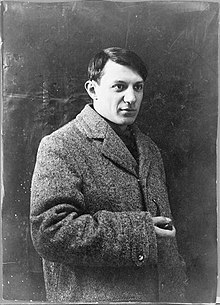
Pablo Picasso
We found 17 free papers on Pablo Picasso
Essay Examples
Overview
Pablo Picasso Girl Before a Mirror Analysis
Pablo Picasso
Girl Before a Mirror shows Picasso’s young mistress Marie-Therese Walter, one of his favorite subjects in the early 1930s. Her white-haloed profile, rendered in a smooth lavender pink, appears serene. But it merges with a more roughly painted, frontal view of her face—a crescent, like the moon, yet intensely yellow, like the sun, and “made…
The Guitar Player by Pablo Picasso
Pablo Picasso
The primary subject matter of abstract painting is the experience of perceiving the painting itself. An observer is not required to go deep in the analysis of its context or its extraneous significance—social, historical, political, cultural and so on. Rather, the observer is merely required to engage the entire visual narrative equipped only with one’s…
Compare and Contrast Between Pablo Picasso’s Les Demoiselles
Pablo Picasso
Although Picasso’s La Damoiselle’s d’ Avignon and Robert Colescott’s La Damoiselle’s d’Alabama come off as very similar works, they also have many differences. Some of these differences are more obvious while others may take the viewer awhile to search out. Behind these differences are reasons as to why the artists painted the work in that…
Pablo Picasso Biography
Pablo Picasso
Pablo R. Picasso is widely considered the foremost figure in 20th-century art because of his extraordinary technical ability, extensive scope, unparalleled creativity, and prolific productivity. Pablo Picasso was born in Malaga, a city in southern Spain, on October 25, 1881, at 11:15 P.M. Despite facing a precarious birth situation where he almost did not survive,…
Essay About Pablo Ruiz Picasso
Cubism
Pablo Picasso
Pablo Picasso is widely recognized as an exceptionally influential artist of the twentieth century. This study follows the evolution of a young Pablo Ruiz Picasso into the visionary who transformed our understanding of art. We begin with his Blue and Rose periods, progress through the emergence of Cubism, and navigate the obstacles encountered during the…
Critical Analysis – Picasso’s Guernica
Aesthetics
Art
Modernism
Pablo Picasso
Painting
Symbolism
Visual Arts
Critical Analysis of Guernica – By Bryce Craig Spanish artist Pablo Picasso can often be collectively seen as the greatest and most influential artist of the twentieth century. In a historical sense he encompassed all that is to be a practicing modernist artist and prevailed as one of the most significant artists overall in human…
Three Stages of Cubism
Art
Pablo Picasso
Painting
The three stages of Cubism with examples It is very clear when you look at these three images, how Cubism developed toward Abstraction. Carefully look at the first image, then follow on to the next and then look at the last one. See how the picture space opens out completely in the last one and…
Picasso Was Mainly a Painter
Cubism
Pablo Picasso
Pablo Picasso was born in Malaga, Spain in 1881. He lived to be 91 years old. And was deeply involved in the major artistic movements of his lifetime. Leading by example– Picasso pushed conventionality. He is the most widely exhibited and discussed artist of the 20th century. (Picasso, p.1) Picasso is credited along with George…
Pablo Picasso Was a Genius of Art
Cubism
Pablo Picasso
“Learn the rules like a pro, so you can break them like an artist” (Picasso). Art has been around for about all of human history, and has told stories of societies, religions, changes and events throughout time. There was one artist though, who affected modern art with his work. This artist was Pablo Picasso. Born…
Who is Pablo Picasso
Cubism
Pablo Picasso
Some say he was superstitious, sarcastic, awful towards his children, and horrible to women. He could very well have been all those things, but one thing I know Pablo Picasso was a great artist. He is one of the fathers of cubism, he had an audience of at least tens of millions. No other painter…
| born | October 25, 1881, Málaga, Spain |
|---|---|
| died | April 8, 1973, Mougins, France |
| description | Pablo Ruiz Picasso was a Spanish painter, sculptor, printmaker, ceramicist and theatre designer who spent most of his adult life in France. |
| children | Paloma Picasso, Maya Widmaier-Picasso, Paulo Picasso |
| movies | The Mystery of Picasso, Steve Jobs, For No Good Reason, Paris Was a Woman, Our World |
| quotations | “Everything you can imagine is real.” “Every child is an artist. “Art is the lie that enables us to realize the truth.” “Art washes away from the soul the dust of everyday life.” “Others have seen what is and asked why. “Learn the rules like a pro, so you can break them like an artist.” |
| information | Periods: Cubism, Surrealism, Expressionism, Post-Impressionism, Neoclassicism Full name: Pablo Diego José Francisco de Paula Juan Nepomuceno María de los Remedios Cipriano de la Santísima Trinidad Ruiz y Picasso Spouse: Jacqueline Roque (m. 1961–1973), Olga Khokhlova (m. 1918–1955) On view: The Museum of Modern Art: New York, The Art Institute of Chicago: Chicago, Chrysler Museum: Norfolk |
Frequently Asked Questions about Pablo Picasso
Don't hesitate to contact us. We are ready to help you 24/7

